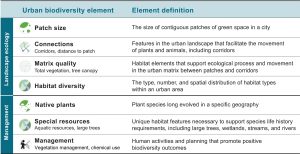Will Biodiversity Actions Yield Healthy Places? A Systematic Review of Human Health Outcomes Associated With Biodiversity-Focused Urban Greening
Citation
Spotswood, E. N., Aronson, M., Bazo, M., Beller, E., Brown, J. D., Dronova, I., Estien, C. O., Frumkin, H., Galarraga, J., Grossinger, R., Hachadoorian, K., Herman, B., Jennings, T., Jennings, V., Kuo, M., McDonald, R. I., Miller, D., Rigolon, A., Symonds, J., & Weinbaum, K. (2025). Will biodiversity actions yield healthy places? A systematic review of human health outcomes associated with biodiversity‐focused urban greening. People and Nature, 00, 1-37. doi.org/10.1002/pan3.70130
Cities around the world are increasingly turning to urban greening projects to boost biodiversity. Efforts such as planting trees, restoring parks, and creating green corridors offer a range of benefits. However, researchers haven’t clearly summarized the specific health impacts of biodiversity-focused greening projects until now.
Researchers conducted a systematic review of 1,550 studies examining how different biodiversity-supporting features in cities—such as large parks, greenways, blue spaces (like lakes and rivers), private gardens, mature trees, and overall urban greenness relate to human health. The evidence shows a wide variety of positive health outcomes. These include better physical and mental health, more physical activity, healthier childhood development, stronger social connections, and reduced exposure to harmful factors like extreme heat, air and noise pollution, and UV radiation.
Read the full plain language summary.
Abstract

- There is growing interest in using urban greening projects to support biodiversity. While there are many potential co-benefits, the health outcomes resulting from biodiversity-supporting activities have yet to be synthesized.
- We conducted a systematic review of health outcomes associated with seven biodiversity-supporting elements, including patch size, connections, matrix quality, habitat diversity, native plants, special resources and vegetation management. We identified 1550 studies linking elements with human health.
- Results show that many types of biodiversity-supporting elements are associated with a wide range of positive health outcomes. These outcomes included improved physical and mental health, increased physical activity, improved childhood development, social outcomes, and reduced exposure to harms such as sun, heat, and pollution (including light, air and noise). Other biodiversity-supporting elements such as reducing pesticide use, native plants, and habitat diversity were associated with a smaller and more specific range of health outcomes.
- While most findings showed positive associations between biodiversity-supporting elements and health, many also yielded mixed, neutral, or negative findings. Further, most identified study designs were observational, limiting our ability to uncover causality. We found that studies using a natural experimental design yielded a greater fraction of mixed, neutral, and negative findings compared to observational designs (the majority of studies) and experimental studies (largely short term in nature). These results confirm concerns about the strength of research findings built largely on correlational research designs.
- We also identify areas of trade-off between biodiversity-supporting elements and human health. These include actions that positively affect health yet negatively impact biodiversity, such as the maintenance of sports fields and trails in parks that can negatively impact habitat and disrupt wildlife behaviour. Biodiversity-supporting elements can also negatively impact some dimensions of human health, including by increasing human–wildlife conflict, disease vectors, allergenic pollen, biogenic volatile organic compounds (BVOCs), through and green gentrification.
- Our review reveals a large potential for co-benefits for human health to come from biodiversity-focused actions in cities. Careful attention to minimizing tensions and trade-offs could help to reduce the potential for conflict between biodiversity and human health objectives.